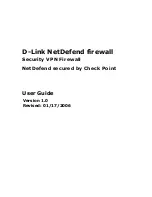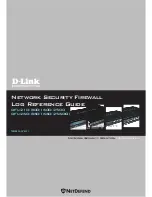
Web Interface
1.
Go to Objects > VPN Objects > IKE Config Mode Pool
2.
The Config Mode Pool object properties web page now appears
3.
Select Use a predefined IPPool object
4.
Choose the ip_pool1 object from the IP Pool drop-down list
5.
Click OK
After defining the Config Mode object, the only remaining action is to enable Config Mode to be
used with the IPsec Tunnel.
Example 9.8. Using Config Mode with IPsec Tunnels
Assuming a predefined tunnel called vpn_tunnel1 this example shows how to enable Config Mode for that tunnel.
Web Interface
•
Go to Interfaces > IPsec
•
Select the tunnel vpn_tunnel1 for editing
•
Select the pool in the IKE Config Mode Pool drop down list
•
Click OK
IP Validation
NetDefendOS always checks if the source IP address of each packet inside an IPsec tunnel is the
same as the IP address assigned to the IPsec client with IKE config mode. If a mismatch is detected
the packet is always dropped and a log message generated with a severity level of Warning. This
message includes the two IP addresses as well as the client identity.
Optionally, the affected SA can be automatically deleted if validation fails by enabling the advanced
setting IPsecDeleteSAOnIPValidationFailure. The default value for this setting is Disabled.
9.4.4. Fetching CRLs from an alternate LDAP server
A Root Certificate usually includes the IP address or hostname of the Certificate Authority to
contact when certificates or CRLs need to be downloaded to the NetDefend Firewall. Lightweight
Directory Access Protocol (LDAP) is used for these downloads.
However, in some scenarios, this information is missing, or the administrator wishes to use another
LDAP server. The LDAP configuration section can then be used to manually specify alternate
LDAP servers.
Example 9.9. Setting up an LDAP server
This example shows how to manually setup and specify an LDAP server.
Command-Line Interface
gw-world:/> add LDAPServer Host=192.168.101.146 Username=myusername
Password=mypassword Port=389
9.4.4. Fetching CRLs from an alternate
LDAP server
Chapter 9. VPN
419
Summary of Contents for DFL-1600 - Security Appliance
Page 27: ...1 3 NetDefendOS State Engine Packet Flow Chapter 1 NetDefendOS Overview 27 ...
Page 79: ...2 7 3 Restore to Factory Defaults Chapter 2 Management and Maintenance 79 ...
Page 146: ...3 9 DNS Chapter 3 Fundamentals 146 ...
Page 227: ...4 7 5 Advanced Settings for Transparent Mode Chapter 4 Routing 227 ...
Page 241: ...5 4 IP Pools Chapter 5 DHCP Services 241 ...
Page 339: ...6 7 Blacklisting Hosts and Networks Chapter 6 Security Mechanisms 339 ...
Page 360: ...7 4 7 SAT and FwdFast Rules Chapter 7 Address Translation 360 ...
Page 382: ...8 3 Customizing HTML Pages Chapter 8 User Authentication 382 ...
Page 386: ... The TLS ALG 9 1 5 The TLS Alternative for VPN Chapter 9 VPN 386 ...
Page 439: ...Figure 9 3 PPTP Client Usage 9 5 4 PPTP L2TP Clients Chapter 9 VPN 439 ...
Page 450: ...9 7 6 Specific Symptoms Chapter 9 VPN 450 ...
Page 488: ...10 4 6 Setting Up SLB_SAT Rules Chapter 10 Traffic Management 488 ...
Page 503: ...11 6 HA Advanced Settings Chapter 11 High Availability 503 ...
Page 510: ...12 3 5 Limitations Chapter 12 ZoneDefense 510 ...
Page 533: ...13 9 Miscellaneous Settings Chapter 13 Advanced Settings 533 ...
















































